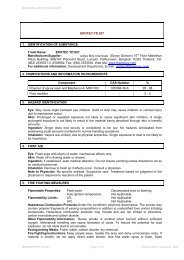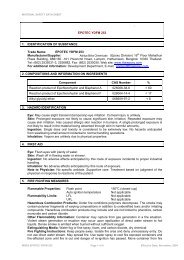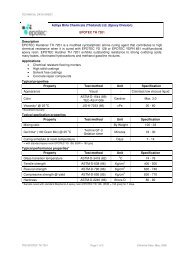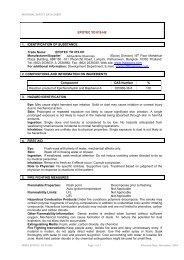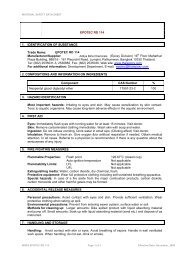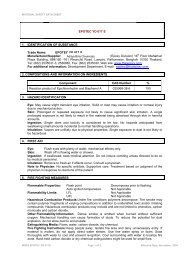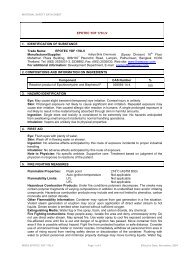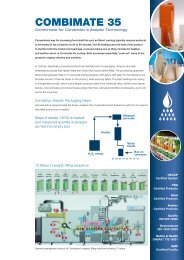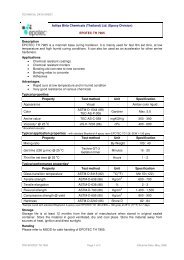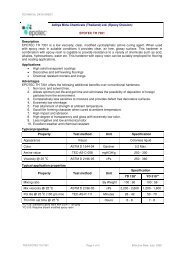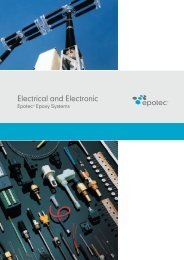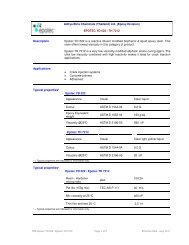EPOTEC YD 127 Manufa - Aditya Birla Chemicals
EPOTEC YD 127 Manufa - Aditya Birla Chemicals
EPOTEC YD 127 Manufa - Aditya Birla Chemicals
You also want an ePaper? Increase the reach of your titles
YUMPU automatically turns print PDFs into web optimized ePapers that Google loves.
MATERIAL SAFETY DATA SHEET<br />
THAI ORGANIC CHEMICALS CO., LTD. (EPOXY DIVISION)<br />
<strong>EPOTEC</strong> <strong>YD</strong> <strong>127</strong><br />
1. IDENTIFICATION OF SUBSTANCE<br />
Trade Name: <strong>EPOTEC</strong> <strong>YD</strong> <strong>127</strong><br />
<strong>Manufa</strong>cturer/Supplier: Thai Organic <strong>Chemicals</strong> Co., Ltd. (Epoxy Division) 16 th Floor Mahathun<br />
Plaza Building, 888/160 - 161 Pleonchit Road, Lumpini, Pathumwan, Bangkok 10330 Thailand.<br />
Tel: (662) 2535031-3, 2536882, Fax: (662) 2535030, Web site: www.thaiepoxy.com<br />
For additional information: Development Department, E-mail: epotec@thaiepoxy.com<br />
2. COMPOSITIONS AND INFORMATION ON INGREDIENTS<br />
Component CAS Number %<br />
Reaction product of Epichlorohydrin and Bisphenol A 025068-38-6 100<br />
3. HAZARD IDENTIFICATION<br />
Eye: May cause slight transient (temporary) eye irritation. Corneal injury is unlikely.<br />
Skin: Prolonged exposure not likely to cause significant skin irritation. Repeated exposure may<br />
cause skin irritation. Has caused allergic skin reaction in humans. A single prolonged exposure is<br />
not likely to result in the material being absorbed through skin in harmful amounts.<br />
Ingestion: Single does oral toxicity is considered to be extremely low. No hazards anticipated<br />
from swallowing small amount incidental to normal handling operations.<br />
Inhalation: Vapors are unlikely due to physical properties.<br />
4. FIRST AID<br />
Eye: Flush eyes with plenty of water.<br />
Skin: Wash off in flowing water or shower.<br />
Ingestion: No adverse effects anticipated by this route of exposure incidental to proper industrial<br />
handling.<br />
Inhalation: No adverse effects anticipated by this route of exposure.<br />
Note to Physician: No specific antidote. Supportive care. Treatment based on judgment of the<br />
physician in response to reactions of the patient.<br />
5. FIRE FIGHTING MEASURES<br />
Flammable Properties: Flash point 252 o C (485 o F) (ASTM D93, PMCC)<br />
Auto ignition temperature Not applicable<br />
Flammability Limits: LFL Not applicable<br />
UFL<br />
Not applicable<br />
Hazardous Combustion Products: Under fire conditions polymers decompose. The smoke may<br />
contain polymer fragments of varying compositions in addition to unidentified toxic and/or irritating<br />
compounds. Hazardous combustion products may include and are not limited to phenolics, carbon<br />
monoxide and carbon dioxide.<br />
Other Flammability Information: Container may rupture from gas generation in a fire situation.<br />
Violent steam generation or eruption may occur upon application of direct water stream to hot<br />
liquids. Dense smoke is emitted when burned without sufficient oxygen.<br />
Extinguishing Media: Water fog or fine spray, foam, and carbon dioxide, dry chemical.<br />
Fire Fighting Instructions: Keep people away. Isolate fire area and deny unnecessary entry. Do<br />
not use direct water stream. May spread fire. Use water spray to cool fire exposed containers and<br />
fire-affected zone until fire is out and danger of re-ignition has passed. Move container from fire<br />
area if this is possible without hazard. Fight fire from protected location or safe distance. Consider<br />
use of unmanned hose holder or monitor nozzles. Immediately withdraw all personnel from area in<br />
case of rising sound from venting safety device or discoloration of the container. Flushing with<br />
water to protect personnel and minimize property damage may move burning liquids. Water fog,<br />
applied gently may be used as a blanket for fire extinguishments. Contain firewater run-off if<br />
possible. Firewater run-off, if not contained may cause environmental damage.<br />
MSDS <strong>EPOTEC</strong> <strong>YD</strong> <strong>127</strong> Page 1 of 4 Effective Date: November, 2004
MATERIAL SAFETY DATA SHEET<br />
Protective Equipments for Fire Fighting: Wear positive pressure self-contained breathing<br />
apparatus (SCBA) and full protective equipment.<br />
6. ACCIDENTAL RELEASE MEASURES<br />
Protect People: Isolate area. Clear non-emergency personnel from area.<br />
Protect the Environment: Keep out of irrigation ditches, sewers and water supplies.<br />
Cleanup: Absorb with material such as sand or polypropylene or polyethylene fiber products.<br />
Collect in suitable and properly labeled containers. Remove residual using hot soapy water.<br />
Residual resin can be removed with solvent. Solvents are not recommended for cleanup unless<br />
the recommended exposure guidelines and safe handling practices for the specific solvent are<br />
followed. Consult appropriate solvent MSDS for handling information.<br />
7. HANDLING AND STORAGE<br />
Handling: Avoid use of electric band heaters. Failures of electric band heaters have been<br />
reported to cause drums of liquid epoxy resin to explode and catch fire. Application of a direct<br />
flame to a container of liquid epoxy resin can also cause explosion and/or fire.<br />
Storage: Good general ventilation should be sufficient for most conditions. Local exhaust<br />
ventilation may be necessary for some operations.<br />
8. EXPOSURE CONTROLS AND PERSONAL PROTECTION<br />
Exposure Guideline(s): None established.<br />
Engineering Controls: Good general ventilation should be sufficient for most conditions.<br />
Eye Protection: Use safety glasses.<br />
Skin Protection: Use protective clothing impervious to this material. Selection of specific items<br />
such as face shields, gloves, boots, apron, or full-body suit will depend on operation. Remove<br />
contaminated clothing immediately, wash skin with soap and water, and launder clothing before<br />
reuse.<br />
Respiratory Protection: No respiratory protection should be needed. If respiratory irritation is<br />
experienced, use an approved air-purifying respirator.<br />
9. PHYSICAL AND CHEMICAL PROPERTIES<br />
Appearance:<br />
Light yellowish liquid<br />
Odor:<br />
Mild epoxy<br />
Boiling Point:<br />
Not applicable<br />
Vapor Pressure: Not applicable<br />
Vapor Density:<br />
Not applicable<br />
Solubility in Water: None<br />
Specific Gravity: 1.16<br />
10. STABILITY AND REACTIVITY<br />
Stability: Stable at ambient temperature.<br />
Conditions to Avoid: Excess heating over long periods of time degrades the resin.<br />
Material to Avoid: Acids, bases, amines and oxidizing agents.<br />
Hazardous Decomposition Products: Refer to section 5 for Hazardous Combustion Products.<br />
Hazardous Polymerization: Will not occur by itself. Polymerization can be catalyzed by aliphatic<br />
amines. Masses of more than one pound (0.5 kg) of product plus an aliphatic amine will cause<br />
irreversible polymerization with considerable heat build up.<br />
11. TOXICOLOGICAL INFORMATION<br />
Acute Oral Toxicity (LD50/Rat):<br />
Acute Dermal Toxicity (LD50/Rabbit):<br />
> 5,000 mg/kg<br />
20,000 mg/kg<br />
12. ECOLOGICAL INFORMATION<br />
Degradation: Theoretical oxygen demand (ThoD) is calculated to be 2.35 p/p. In the atmospheric<br />
environment, material is estimated to have a tropospheric half-life of 1.92 hr. Biodegradation<br />
reached in Modified Zahn-Wellens / EMPA Test (OECD Test No. 302B) after 28 days: 12%. 20-<br />
Day biochemical oxygen demand (BOD20) is
MATERIAL SAFETY DATA SHEET<br />
Ecotoxicity: Material is moderately toxic to aquatic organisms on an acute basis (LC50 / EC50<br />
between 1 and 10 mg/L in most sensitive species). Acute LC50 for water flea Daphnia magna is<br />
1.3 mg/L. Acute LC50 for fathead minnow (Pimephales promelas) is 3.1 mg/L. Toxicity to aquatic<br />
species occurs at concentrations greater than water solubility. Maximum acceptable toxicant<br />
concentration (MATC) in water flea Daphnia magna is 0.55 mg/L. Growth inhibition threshold in<br />
bacteria is >42.6 mg C/L. Inhibitory concentration (IC50) in OECD Activated Sludge Respiration<br />
Inhibition Test (OECD Test No. 209) is >100 mg/L.<br />
13. DISPOSAL CONSIDERATIONS<br />
Disposal: Do not dump into any sewers, on the ground, or into any body of water. All disposal<br />
methods must be in compliance with all applicable federal, state/provincial and local laws and<br />
regulations. Regulations may vary in different locations. Waste characterizations and compliance<br />
with applicable laws are the responsibility solely of the waste generator.<br />
14. TRANSPORT INFORMATION<br />
Department of Transportation: For D.O.T. regulatory information, if required, consults<br />
transportation regulations, product-shipping papers.<br />
Canadian TDG Information: For TDG regulatory information, if required, consult transportation<br />
regulations, product shipping papers.<br />
15. REGULATORY INFORMATION<br />
Notice: The information herein is presented in good faith and believed to be accurate as of the<br />
effective date shown above. However, no warranty, express or implied is given. Regulatory<br />
requirements are subject to change and may differ from one location to another; it is the buyer ‘s<br />
responsibility to ensure that its activities comply with federal, state or provincial and local laws.<br />
The following specific information is made for the purpose of complying with numerous federal,<br />
state or provincial and local laws and regulations.<br />
U.S. REGULATIONS:<br />
SARA 313 INFORMATION: To the best of our knowledge, this product contains no chemical<br />
subject to SARA Title III Section 313 supplier notification requirements.<br />
SARA HAZARD CATEGORY: This product has been reviewed according to the EPA "Hazard<br />
Categories" promulgated under Sections 311 and 312 of the Superfund Amendment and<br />
Reauthorization Act of 1986 (SARA Title III) and is considered, under applicable definitions, to<br />
meet the following categories: An immediate health hazard<br />
This product has been classified as "an immediate heath hazard" due to the potential for allergic<br />
skin reaction.<br />
TOXIC SUBSTANCES CONTROL ACT (TSCA): All ingredients are on the TSCA inventory or are<br />
not required to be listed on the TSCA inventory.<br />
OSHA HAZARD COMMUNICATION STANDARD: This product is a "Hazardous Chemical" as<br />
defined by the OSHA Hazard Communication Standard, 29 CFR 1910.1200.<br />
CANADIAN REGULATIONS:<br />
WHMIS INFORMATION: The Canadian Workplace Hazardous Materials Information System<br />
(WHMIS) Classification for this product is: D2B - skin sensitizer<br />
Refer elsewhere in the MSDS for specific warnings and safe handling information.<br />
CPR STATEMENT: This product has been classified in accordance with the hazard criteria of the<br />
Canadian Controlled Products Regulations (CPR) and the MSDS contains all the information<br />
required by the CPR.<br />
CANADIAN ENVIRONMENTAL PROTECTION ACT (CEPA):<br />
All substances in this product are listed on the Canadian Domestic Substances List (DSL) or are<br />
not required to be listed.<br />
16. OTHER INFORMATION<br />
The information presented herein is based on data considered to be accurate as of date of<br />
preparation of the Material Safety Data Sheet. However, no warranty or representation, express<br />
or implied, is made as to the accuracy or completeness of the foregoing data and safety<br />
information, nor is any authorization given or implied to practice any patented invention without a<br />
license. In addition, no responsibility can be assumed by vendor for any damage or injury<br />
resulting from abnormal use, from any failure to adhere to recommended practices, or from any<br />
hazards inherent in the nature of the product.<br />
MSDS <strong>EPOTEC</strong> <strong>YD</strong> <strong>127</strong> Page 3 of 4 Effective Date: November, 2004



